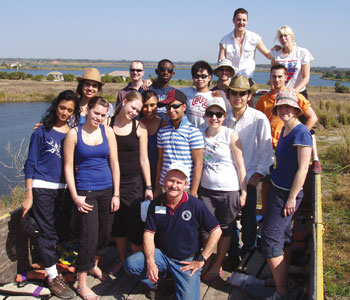 Brandt Henningsen, District chief environmental scientist, center, and Dr. Kate Spencer, right, with her students from the University of London.
Brandt Henningsen, District chief environmental scientist, center, and Dr. Kate Spencer, right, with her students from the University of London.
Each winter for the past eight years, Dr. Kate Spencer, a University of London professor, has brought a group of her students to the Tampa Bay area to tour District coastal ecosystem restoration projects and the TECO Manatee Viewing Center.
Spencer has been bringing student groups to Florida since 2000, and she began to include the Tampa Bay area in 2002. The trip is part of a third-year undergraduate module called “Coastal and Aquatic Management,” which examines environmental problems, management and restoration in a variety of aquatic environments.
“The Tampa Bay estuary is an excellent example of a large-scale, integrated restoration project,” said Spencer. “There are a number of aspects of the project that are particularly interesting and make the trip worthwhile.”
Spencer learned about the Tampa Bay Estuary Program while attending an Estuarine Research Federation conference. A Florida Marine Research Institute scientist she met at the conference put her in touch with Brandt Henningsen, District chief environmental scientist with the Surface Water Improvement and Management Program.
This year, Henningsen and Richard Sullivan, manager of Hillsborough County’s Cockroach Bay Aquatic Preserve, led the group on a tour of the Cockroach Bay and Terra Ceia Ecosystem restoration projects. Sullivan provided a flatbed trailer for the group to use during the land portion of the Cockroach Bay tour. He also provided canoes for the water portion of the tour, which took them to two of the estuarine wetland restoration phases and the natural estuarine areas of Little Cockroach Bay (Tampa Bay).
“We are honored to have the University of London faculty and students so interested in what we are doing to restore and manage the Tampa Bay ecosystem,” said Henningsen. “Hopefully, some of the lessons learned here will have applications in England.”
Spencer says the solid science behind the restoration and management of the estuary and the strong public participation are two reasons she keeps returning.
“It’s interesting for us to see how the project has developed such strong ties with the community and a range of stakeholders,” said Spencer. “There’s also a real longevity and vision to this project. We’ve been able to see it develop with time and adapt to changes in environmental policy and thinking.”
In addition to studying the Tampa Bay area, Spencer and her students also spend a week examining the Everglades watershed. They start at the Kissimmee River and work their way down to Lake Okeechobee, the Everglades, Florida Bay and the Keys.
“I’d also like to point out how great it is for our students to meet such committed and enthusiastic scientists,” said Spencer. “It really helps them to think about careers as they are coming to the end of their studies.”
